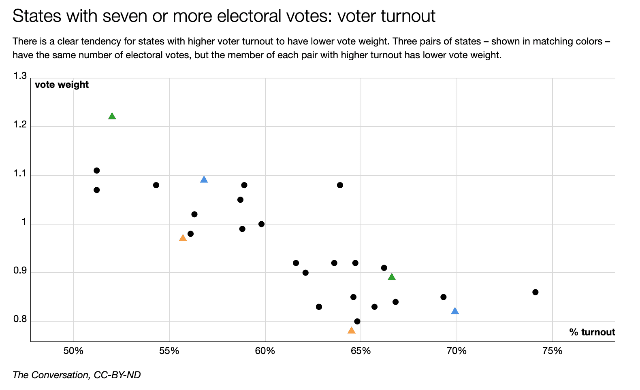It’s obvious that the Electoral College distorts the popular vote in presidential elections, because small states get more votes than populous states.
That’s because electoral votes are allocated to each state based on the number of representatives it has in Congress. While House of Representatives districts are decided roughly proportionate to population, each state — no matter the size — also has two senators.
As Katy Collin explains:
That means that even the least populous state — Wyoming, with 586,107 residents — gets three electoral college votes. How disproportionate is that? Consider that California, the most populous state, has 39,144,818 residents and 55 electoral college votes.
That means that in the electoral college, each individual Wyoming vote weighs 3.6 times more than an individual Californian’s vote. That’s the most extreme example, but if you average the 10 most populous states and compare the power of their residents’ votes to those of the 10 least populous states, you get a ratio of 1 to 2.5.
But using a state’s population is not entirely accurate in determining the value of an electoral vote since not every person votes. A better method would be to use the number people who actually voted.
Crunching the Numbers
Approximately 136 million people voted in the 2016 presidential election. Simple math suggests that, on average, each person’s vote counted for a four millionths of an Electoral College vote.
Dale Durran found the relative weight of a vote in each state by dividing each state’s electoral vote total by the total number of ballots cast in that state, and then divided again by the exact fraction of an Electoral College vote accorded the average American voter (roughly four millionths).
Durran found that voters in Wyoming did have the most weight, 2.97, for their votes. Voters in Florida came out on the bottom, with a voting weight of just 0.78. The weight given to the votes in Louisiana exactly matched the national average of one.
But the most striking finding in the above table is that, except for Florida, the states with the smallest weights are actually mid sized, those that have between seven and 20 electoral votes each.
Durran also found that voter turnout explains the low vote weights in states with seven or more electoral votes.

It makes sense that higher turnout in a state decreases the Electoral College weight of each ballot because the fixed number of electoral votes for any given state must be shared among the total number of ballots cast.
Durran explains:
For example, consider the difference between Oklahoma and Oregon. Both states have seven electoral votes, but their weights, 1.22 and 0.89, are quite different. That’s primarily because only 52 percent of eligible voters turned out in Oklahoma – much less than the 66.6 percent turnout in Oregon. That gave Oklahomans a greater weight per vote in the Electoral College than their fellow citizens in Oregon.
In another example, South Carolina saw a relatively low 56.8 percent turnout, versus the much higher 69.8 percent turnout in Colorado. Both states have nine electoral votes. But, as a consequence of voter turnout, ballots in South Carolina received a weight of 1.09, while those in Colorado were given a much lower weight of 0.82.
Voters Are Penalized In High Turnout States
So while it’s clear the Electoral College adds extra weight to the value of individual votes in low population states, it’s a bit surprising that, for at least the midsize states, it tends to weigh votes more based on that state’s turnout rather than its number of electoral votes.
Whatever you might think of the Electoral College, it seems unfair that the system penalizes voters who live in high-turnout states.
